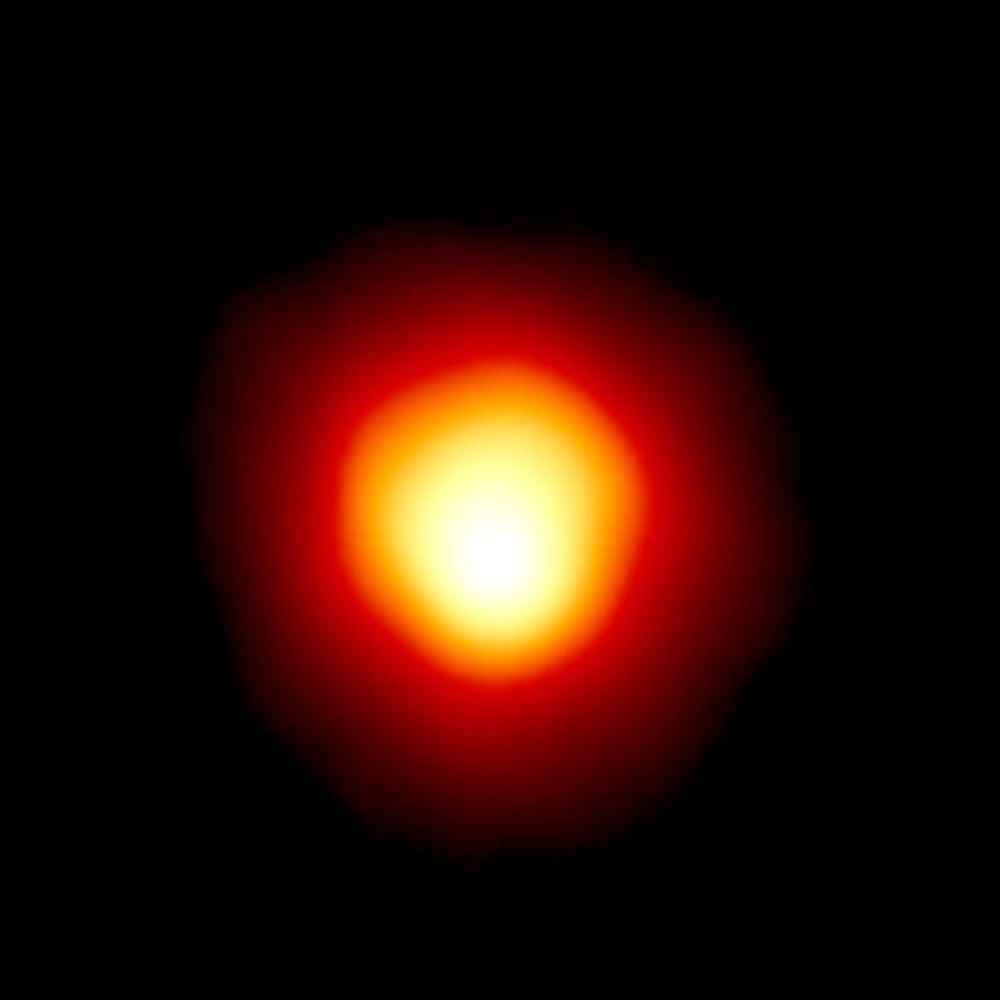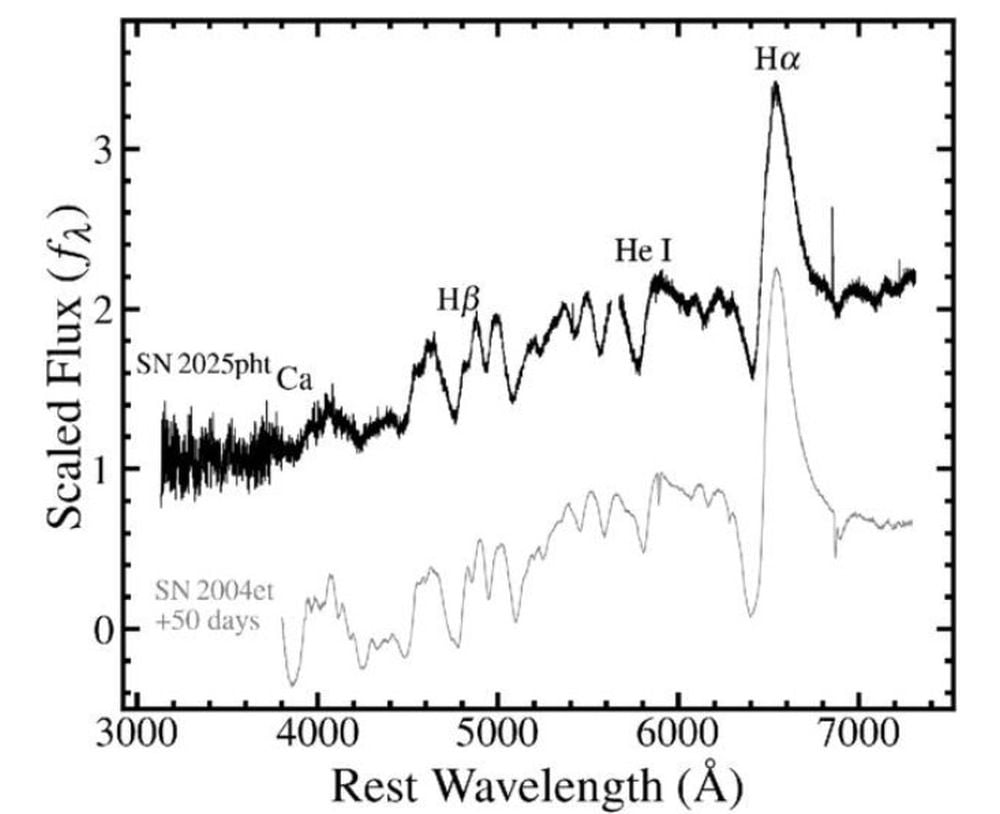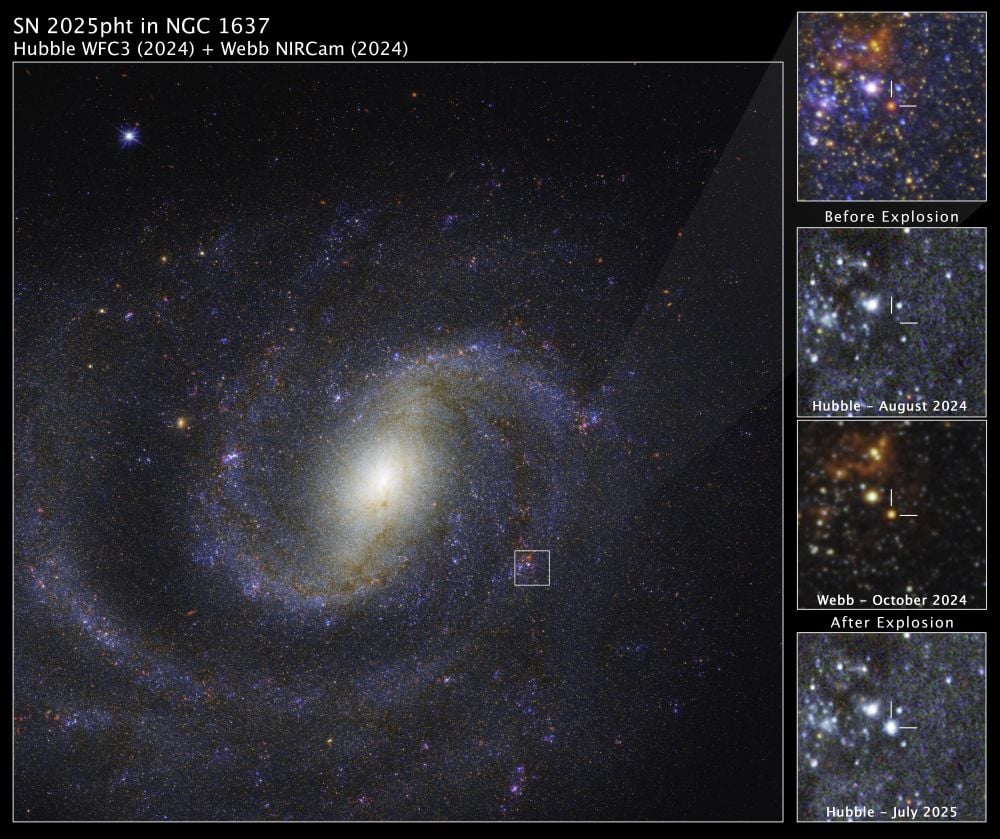Not all stars get to live long fruitful lives, surrounded by their orbiting, planetary offspring. A substantial fraction of stars never get to become white dwarfs like our Sun will, and spend a long retirement radiating their remnant energy. Those stars face quick obliteration in the form of cataclysmic explosions.
Red supergiants are one type of exploding star. They evolve from huge main sequence stars with between about 8 and 40 solar masses. Eventually these stars run out of hydrogen and start fusing helium and then heavier elements. Ultimately they explode as supernovae, and models show that they make up the bulk of core-collapse supernovae.
But there’s a problem: astronomers can’t see them.
New research in The Astrophysical Journal Letters presents observations of an exploding red supergiant inside a massive cloak of obscuring dust. It’s titled “The Type II SN 2025pht in NGC 1637: A Red Supergiant with Carbon-rich Circumstellar Dust as the First JWST Detection of a Supernova Progenitor Star.” The lead author is Charles Kilpatrick, a research assistant professor at Northwestern University’s Center for Interdisciplinary Exploration and Research in Astrophysics.
The JWST is to thank for this discovery, with some help from the venerable Hubble Space Telescope. Hubble’s archival images of the galaxy allowed the astronomers to view the progenitor prior to the explosion. The telescopic duo discovered the red supergiant progenitor star in NGC 1637, a spiral galaxy about 32 million light years away.
“We present follow-up imaging and spectroscopy and pre-explosion imaging of SN 2025pht located in NGC 1637 at 12 Mpc,” the researchers write in their research. “NGC 1637 was the target of several epochs of Hubble Space Telescope (HST) and James Webb Space Telescope (JWST) imaging covering the site of SN 2025pht from 31 to 0.7 yr prior to discovery.”
This discovery is important because of what astronomers call the ‘red supergiant problem.’
Detailed astrophysical theories show that massive stars should end their lives as red supergiants (RSG) that then explode as supernovae. But astronomers struggle to observe evidence of this. Many of the RSGs that astronomers find are not as luminous as they should be, according to theory. The ones they do observe have lower than predicted luminosities. They should be finding RSGs that are about 500,000 times as luminous as our Sun, but detections top out at around 300,000 to 350,000 solar luminosities.
 *Betelgeuse is the most well-known red supergiant. In recent years it’s experienced dimming that led to speculations about when it will explode as a supernova. Research determined that the dimming was due to increased dust extinction. Image Credit: Andrea Dupree (Harvard-Smithsonian CfA), Ronald Gilliland (STScI), NASA and ESA*
*Betelgeuse is the most well-known red supergiant. In recent years it’s experienced dimming that led to speculations about when it will explode as a supernova. Research determined that the dimming was due to increased dust extinction. Image Credit: Andrea Dupree (Harvard-Smithsonian CfA), Ronald Gilliland (STScI), NASA and ESA*
There are a handful of explanations that account for this luminosity discrepancy.
It’s possible that they simply lose mass through their stellar winds more rapidly than thought. Lower mass means lower luminosity. Or it could come down to internal mixing and convection. Maybe our astrophysical understanding of those processes is incomplete.
Another potential explanation involves binary evolution. Most RSGs exist in binary systems, and interaction between the pair of stars could affect luminosity.
Or it might be something simpler. Perhaps these RSGs are simply obscured by dust, or another observational bias prevents their detection.
The JWST was built with the specific capability to see through dust better than other telescopes. In this work, the powerful infrared telescope was able to pierce the dust cloaking the RSG. By doing so, it’s helped solve the red supergiant problem. But it needs to be said that without the Hubble’s decades of service, the JWST would not have made this discovery.
“For multiple decades, we have been trying to determine exactly what the explosions of red supergiant stars look like,” said lead author Kilpatrick in a press release. “Only now, with JWST, do we finally have the quality of data and infrared observations that allow us to say precisely the exact type of red supergiant that exploded and what its immediate environment looked like. We’ve been waiting for this to happen — for a supernova to explode in a galaxy that JWST had already observed. We combined Hubble and JWST data sets to completely characterize this star for the first time.”
This scientific discovery begins on June 29th, 2025, when the All-Sky Automated Survey of Supernovae discovered SN2025pht. The researchers gathered HST images from the before the SN, and JWST images from after the SN. That allowed them to isolate the progenitor star. Even though it was bright, much of its light was dimmed by thick dust. The star is about 100,000 times more luminous than the Sun but its light was attenuated by the dusty veil. Its optical output was especially affected by the dust, making its optical light about 100 times dimmer. Since dust blocks bluer wavelengths of light, the star also appeared very red. It all adds up to a very bright, very red star.
“It’s the reddest, dustiest red supergiant that we’ve seen explode as a supernova,” said co-author Aswin Suresh, a graduate student in physics and astronomy at Northwestern’s Weinberg College of Arts and Sciences.
 *This image shows the spectrum of SN 2025pht from Keck compared to that of a known supernova, SN 2004et. This helped confirm that what the astronomers were seeing was indeed a supernova. Image Credit: Kilpatrick et al. 2025. ApJL*
*This image shows the spectrum of SN 2025pht from Keck compared to that of a known supernova, SN 2004et. This helped confirm that what the astronomers were seeing was indeed a supernova. Image Credit: Kilpatrick et al. 2025. ApJL*
“SN2025pht is surprising because it appeared much redder than almost any other red supergiant we’ve seen explode as a supernova,” Kilpatrick added. “That tells us that previous explosions might have been much more luminous than we thought because we didn’t have the same quality of infrared data that JWST can now provide.”
When it comes to the red supergiant problem, many astrophysicist have supported the idea that dust is the cause. Thicker dust than thought may be the norm, explaining why scientists don’t observe RSGs as bright as theory says they should be. Kilpatrick, a recognized expert on the life and death of stars, has supported the dust solution to the problem.
“I’ve been arguing in favor of that interpretation, but even I didn’t expect to see such an extreme example as SN2025pht,” Kilpatrick said. “It would explain why these more massive supergiants are missing because they tend to be dustier.”
The JWST also detected the chemical components of the star’s dust. RSGs tend to produce silicate dust that’s enriched with oxygen, but SN2025pht is different. Its dust seems to be enriched with carbon. After RSGs have exhausted their hydrogen, they begin fusing helium. That produces carbon, which in this case, may have been dredged up from within the star by powerful convection forces.
In their research letter, the authors note that a superwind or some type of outburst could be responsible for the carbon. That has implications for understanding RSGs that explode as SNe, and the material that surrounds them. This could make them easier to recognize in the future. “If this mechanism is energetic enough to initiate post He-burning dredge-up from the base of the RSG’s convective envelope, it could simultaneously explain both the presence and composition of the CSM around SN progenitor stars similar to SN 2025pht,” the researchers write.
Overall, the JWST’s detection of elevated levels of carbon came as a surprise.
“The infrared wavelengths of our observations overlap with an important silicate dust feature that’s characteristic of some red supergiant spectra,” Kilpatrick said. “This tells us that the wind was very rich in carbon and less rich in oxygen, which also was somewhat surprising for a red supergiant of this mass.”
This is another first for the JWST. It’s the first time that astronomers have used it to identify a SN progenitor star. Now Kilpatrick’s research team is searching for more RSGs that will expode as SN in the future. NASA’s next powerful space telescope, the Nancy Grace Roman Space Telescope, should make great headway in this search.
“With the launch of JWST and upcoming Roman launch, this is an exciting time to study massive stars and supernova progenitors,” Kilpatrick said. “The quality of data and new findings we will make will exceed anything observed in the past 30 years.”
The Roman Space Telescope’s field of view is about 100 times larger than the JWST’s, and it can perform large surveys of the sky, seeking out patterns and unusual objects. Unfortunately, Trump has threatened to cancel the project, even though it’s nearly complete and is on budget and on schedule for a launch in late 2026.
“SN 2025pht represents the beginning of SN progenitor star analyses performed with JWST,” the authors write in their research. The telescope’s NIRCam and MIRI instruments provide broad wavelength coverage and precise photometry, allowing astronomers to gain more detailed insight into the nature of the dust that surrounds RSGs.
“By answering long-standing questions about the terminal states of massive stars, we are now better able to bridge the gap between direct imaging of SN progenitor systems and indirect constraints from their pre-explosion outbursts, early light curves, and flash spectroscopy,” the authors conclude.
